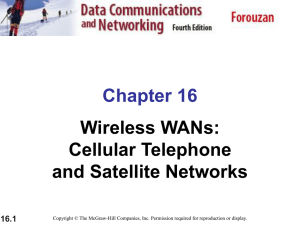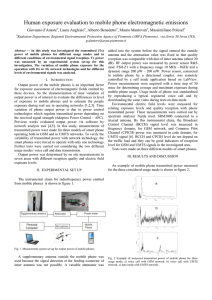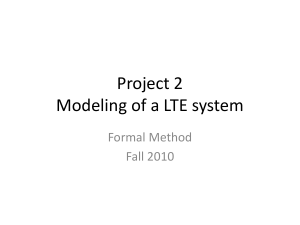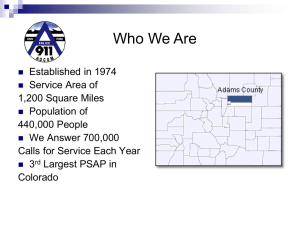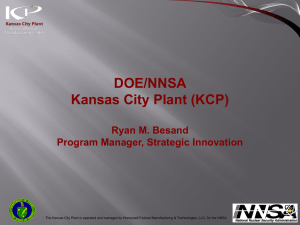LTE
advertisement
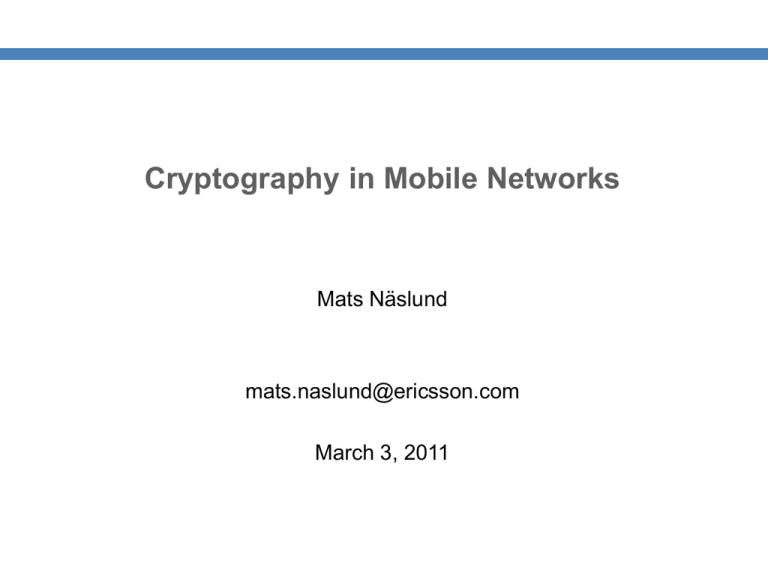
Cryptography in Mobile Networks Mats Näslund mats.naslund@ericsson.com March 3, 2011 Outline • Overview of GSM Cryptography • Some “attacks” on GSM – Lessons to be learnt • Overview of “3G” UMTS Cryptography • The new ”thing”: Cryptography in LTE 2 2011-03-02 History • Mobile (wireless) communication has inherent threats – – – – Eavesdropping Impersonation Connection hijacking ... • Except early systems (e.g. NMT), use of cryptography has been deemed necessary - Protection of buisness (robust charging of subscribers) - User privacy • Early systems were not perfect and under restrictions... 3 2011-03-02 GSM Cryptography Overview 4 2011-03-02 GSM Security • Use of a smart card SIM – Subscriber Identity Module, tamper resistant device holding critical information, – e.g. 128-bit key shared with Home Operator • The SIM is the entity which is authenticated – Challenge response mechanism (one-sided) • At the time (ca 1990) crypto was considered “weapon” – Initial GSM algorithms (were) not publicly available – Limited key size – Special “export version” of encryption algorithms • GSM ciphering on “first hop” only: stream ciphers using 54/64 bit keys – Today 128 bits can be supported in GSM • Basic user identity protection (“pseudonyms”) 5 2011-03-02 GSM Architecture (”2G”) K To other (mobile) network(s) Encryption: A5/1, A5/3 (64 bit) A5/2 (”export” version) A5/4 (128 bits, new) HLR/AuC MSC: Mobile Switching Center BSC: Base Station Controller RBS: Radio Base Station MS: Mobile Station HLR: Home Location Register AuC: Authentication Center SIM: Subcriber Identity Module MSC BSC Authentication, shared key, A3 Algorithm RBS K MS SIM 6 128-bit key 2011-03-02 GSM Authentication: Overview Home Network K Req(IMSI) RAND K RAND, Kc RES AuC/HLR RAND, XRES, Kc MSC RBS RES = XRES ? Visited Network 7 2011-03-02 GSM Authentication: Details A3 and A8: Authentication and key derivation (proprietary) A5: encryption (A5/1-4, standardized) Note: one-sided authentication Phone SIM Ki (128) A3 A8 frame# data/speech RAND (128) RES (32) Kc (64) A5/x 8 encrypted frame Bit-by-bit, stream cipher 2011-03-02 Quick Note: LFSR (Linear feedback shift register) key = 0 1 1 0 1 0 1 State: 10 01 1 1 10 01 10 01 output ...0 1 XOR:ed with plaintext Very efficient, rich theory, unfortunately very insecure… • Add non-linear components • Combine several LFSRs Used by A5/1 and A5/2 • Irregular clocking 9 2011-03-02 August 2003: Attack on A5/2 Published 10 2011-03-02 Idea behind the attack A5/2 is highly ”linear”, can be expressed as linear equation system in 660 unknown 0/1 variables, of which 64 is the key If plaintext known, each 114-bit frame gives 114 equations Only difference between frames is that frame number Lesson #1: Avoid using the same key for two increases by one. different things After 6 frames (in reality only 4) we have > 660 equations can solve! (Takes about 1sec on a PC) Even if “speech” plaintext unknown, GSM control channels contains known info and uses same key as speech channel! 11 2011-03-02 Impact 1: Find key, eavesdrop (passive attack) Impact 2: Active attacks in any network Lesson #2: Signalling that controls (False base-station/man-in-the-middle attacks)the security 1 RAND 2 RAND should be authentciated/integrity 4 RES 3 RES protected 5 Start encr: A5/1 6 Start encr: A5/2 8 Stop encr 9 Start encr: A5/1 Lesson #3: If you change encryption algorithm, change also the key 7 Attack key 12 2011-03-02 Note • A5/2 is an ”export” version, not used in Sweden (or Europe) • Attack does not apply to A5/1, A5/3 • Various countermeasures proposed but expensive to upgrade all equipment – Adding integrity, change of keys as proposed on previous slide fall into the ”not-for-free” category • Simple and quite good solution is to phase out A5/2 -This has already been implemented 13 2011-03-02 Inherent GSM Problem • Originally designed for max 64 bit keys • Sophisticated “dictionary” attacks possible: rainbow tables – Hellman time-memory trade-off r11 f r12 f … f r1m r21 f r22 f … f r2m … rn1 f … rn2 f … (64-bit keys ~ 2TB storage) Given: r = f(x) f … r = r1 f rnm ? stored r2 … rt Could hope to find x if nt > 264 14 2011-03-02 Inherent GSM Problem (cont’d) • Using current technology, this is within reach and tables for A5/1 exist – Nvidia GPUs Support for 128 bit keys is essential! – Bit-torrent Support added in need standard 2009 • Until recently only was obstacle was for aDecember “GSM radio interceptor” (May in however • Developments 2010: not be widely deployed yet…) - USRP (Software Defined Radio) - Open BSS source code ~ $1500 15 + OsmocommBB ~ $100 2011-03-02 GSM Summary • • • • GSM was desiged in the ”dark ages” of crypto It addresses the threats that were considered at the time It targeted a 10-year ”economic lifetime” The best feature of GSM security is that securiy is built-in – as a user, you don’t need to do ”configuration” etc 16 2011-03-02 UMTS Security Overview 17 2011-03-02 3G (UMTS) Security Described later • Mutual Authentication with Replay Protection • Protection of signalling data Lesson #2… – Secure negotiation of protection algorithms – Integrity protection and origin authentication – Encryption Only feature common • Protection of user data payload to GSM – Encryption • “Open” algorithms basis for security – AES for authentication and key agreement – Kasumi (block cipher) for confidentiality/integrity • Security level (key sizes): 128 bits • Protection further into the network 18 2011-03-02 UMTS Architecture (”3G”) K To other (mobile) network(s) Encryption: UEA1 or UEA2 GSN: GPRS Support Node SGSN: Serving GSN GGSN: Gateway GSN RNC: Radio Network Controller ME: Mobile Equipment HLR/AuC GPRS, ”2.5G” MSC SGSN RNC ”secure env” Signalling integrity: UIA1 or UIA2 GGSN ”Internet” Authentication, shared key Milenage (AES) algorithm ”insecure env” NodeB K UMTS SIM (USIM) ME 19 2011-03-02 UMTS Encryption Example: UEA1 COUNT || BEARER || DIR || 0…0 (64 bits) Kasumi m (const) CK (128 bits) Kasumi c=1 Kasumi c=2 Kasumi Kasumi “keystream” XOR:ed with plaintext 20 c=B 2011-03-02 Note • There are no known security problems with UMTS • HSPA (a.k.a. ”Mobile broadband”, ”Turbo 3G”,...) is from crypto/security point of view identical to 3G/UMTS – You can feel safe when using it! 21 2011-03-02 LTE: Long Term Evolution Background: Standardization • Mobile standards (including security functions) are defined by 3GPP (part of ETSI) – Participation by mobile vendors and operators • The cryptography is defined by SAGE (also part of ETSI) – Special Algorithm Group of Experts • 2006: initiative for ”next generation”, LTE, started – Slogan: ”At least as secure as UMTS” • First LTE standard ready 2008 after large efforts - Example: considering only Ericsson and only security, we had 240 contributions during 2008 • Commercial availability recently 23 2011-03-02 LTE Thinking Starting from a UMTS network... IP part, efficient, cheap, attaractive services: keep and optimize! HLR/AuC split Oldfashioned After 1 years of discussion in ”telephony”: decided toGGSN get rid ofstandardization it! MSC it was SGSN terminate (most) security in NodeB. Powerful but complex, adds delay/latency RNC ”secure env” ”insecure env” New ”radio”, ~ 100Mb/s (OFDM) ? ”Internet” But what do we do with encryption? NodeB High security: keep SIM concept ME 24 2011-03-02 LTE - A simplified network - HSS: Home Subscriber System MME: Mobility Management Entity eNodeB: Evolved NodeB encryption intgegrity HSS K ”split” into control and user plane “Gateway” Internet & IP services MME Re-encryption of user traffic (IPsec) Authentication, similar to UMTS Encryption/integrity, for network control signalling eNodeB Encryption/integrity, for radio control signalling 5 different keys used... Same USIM as in UMTS but K may be up to 256 bits K 25 ME Encryption for user traffic 2011-03-02 Recap of Lesson #1 and #3 ”Don’t use the same key for two different things” Suppose we have a function, F, from a set of pseudo random functions (outputs ”look” random): Key F(Key, ”1”) Key1 F(Key, ”2”) Key2 Applications: • Key1 for algorithm1, Key2 for algorithm2 • Key1 for encryption, Key2 for integrity • Key1 for user data, Key2 for control sign. • ...etc... * Key1 can not be reverse-engineered from Key2 (or v.v.) * Key can not be reverse-engineered from Key1 and/or Key2 26 2011-03-02 Fasten Seatbelts... • Notation: – – – – black color for unprotected info red color for encrypted into yellow color for integrity protected info blue color for encrypted and integrity protected • Next slides does not show which-key-is-used-for-what • F denotes a PRF based on HMAC_SHA256 • AES1, AES2, AES3 denotes 3 PRFs based on AES 27 2011-03-02 LTE: Initial Attach K eNB - Does AUTN come from HSS? MME - Have I seen it before? ATTACH REQUEST (IMSI, SUPPORTED_ALGS) = AES2(K, RAND) 3. (Ck, Ik) = AES3(K, RAND) RES, Ck, Ik RES Derive KA, Ke .... K AUTH VECT FETCH (IMSI) 1. Check (AES1(K, RAND), SQN, AUTN)) 2. RES HSS RAND, XRES, AUTN, KA RAND, AUTN RAND = RANDOM() Check: RES == XRES ?? SQN = SQN + 1 AUTN = AES1(K, RAND, SQN) XRES = AES2(K, AND) ”OK”, SELECTED_ALG, (Ck, Ik) = AES3(K, KA RAND) SUPPORTED_ALGS F KA = F(Ck, Ik, ...) - Verify ”OK” - Switch ”on” security Ke KN-int [”OK”] Ke Protected signaling Protected traffic Ke F 28 KeUP-enc KeRRC-int KeRRC-enc 2011-03-02 KN-enc LTE: Key Hirearchy K ”Downward” derivation by one-way function, infeasible to get ”high” key from a ”low” key USIM/HSS CK IK ME/HSS KA ME/MME KN-int KN-enc Ke ME/eNB ME/MME KeUP-enc KeRRC-int KeRRC-enc PRF: infeasible to to get another key on ”same level” 29 2011-03-02 Example Ck, Ik HSS KA = F(Ck, Ik, ....) MME KA Ke = F(KA, ....) Ke eNodeB 30 2011-03-02 LTE Key Handling at Handover (1/3) ”Backward Security” KA Gateway MME Ke2 = F(Ke1,...) eNodeB1 Ke1 Ke2 eNodeB2 Ke2 ”Handover to eNodeB2” Ke2 KA, Ke1, ... 31 2011-03-02 LTE Key Handling at Handover (2/3) KA Gateway MME eNodeB1 Ke1 Ke2 eNodeB2 Ke2 Ke2 = F(Ke1,...) Ke2 KA, Ke1, ... 32 2011-03-02 LTE Key Handling at Handover (3/3) ”Forward Security” Ke2* = F(KA,...) KA Gateway MME Ke2* eNodeB1 Ke1 keys etc eNodeB2 Ke2 Ke2* Ke2 = F(Ke1,...) Ke2 Ke2* KA, Ke1, ... 33 2011-03-02 Inter-System Handover/Mobility • 3GPP systems support optimized handover between systems,e.g. GSM UMTS during an ongoing call • Waiting for (re)authentication too expensive -The ongoing call would be halted • Solution: key transfer and implict authentication... 34 2011-03-02 Implicit Authetication User already authenticated in GSM May need transatalantic communication... HLR/AuC KGSM MSC KGSM BSC KGSM ... moves to UMTS SGSN RNC KUMTS = c(KGSM) Also, c is a weak XOR-function KUMTS NodeB RBS KGSM The fact that user was able to produce the correct KUMTS ”proves” or...? that it is the same user KUMTS = c(KGSM) 35 2011-03-02 LTE Inter-system Key Handling Example: UMTS LTE UMTS LTE KLTE = F1(KUMTS) KUMTS SGSN KLTE MME KUMTS = F2(KLTE) RNC NodeB eNodeB F1, F2 based on HMAC_SHA256 36 2011-03-02 Note on ”Crypto capacity” Dedicated Crypto HW Gateway May serve 3-6 ”cells” / ”phones” Quite high ”crypto load”, say ~ 102 base stations 600Mb/s 100Mb/s NodeB 100Mb/s 37 2011-03-02 LTE Crypto Algorithms... • Key derivation (128 or 256 bits) functions using – AES on the USIM card – HMAC_SHA256 in ”the phone” • Integrity protection – AES-CMAC – Function based on polynomials over finite fields • Can be ”proven” to be secure • Encryption – AES in so called Counter Mode – SNOW 3G – ZUC, ”The chineese algorithm” 38 2011-03-02 SNOW 3G Basic design by T. Johansson & P. Ekdahl (U. Lund) Improvements by ETSI SAGE 39 2011-03-02 Summary • Despite some attacks on GSM security, the security is so far pretty much a success story Main reason: convenience and invisibility to user • UMTS crypto significantly improved, use with confidence Main reason: free world, longer keys, “open” standard • LTE much more complex, needed to meet “at least as secure as 3G” Main reason: security “ends” at the base station 40 2011-03-02


